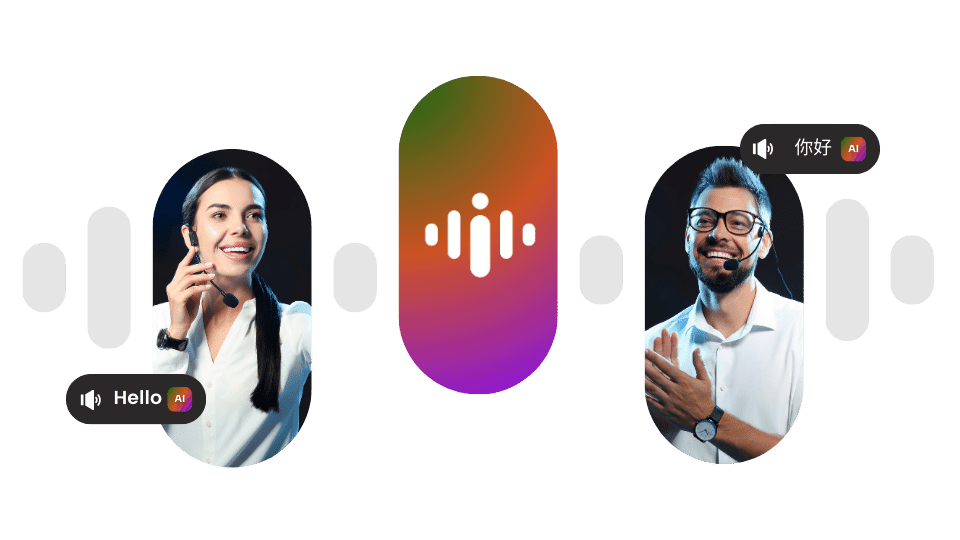Want to understand what makes one speech translation solution better than another? Consider the words ‘except’ and ‘accept.’ Though only a couple of letters apart, their meanings are entirely different. ‘Accept’ means to receive or agree to something. ‘Except’ means to exclude something.
But what happens when a speaker sounds like they’re saying ‘except’ when they mean to say ‘accept?’ Here, a professional interpreter will use context clues, training, and experience to provide an accurate translation. This precision is key, as even the smallest translation changes can lead to miscommunication.
With so many cost-effective AI tools on the market, you may be wondering if AI tools are precise enough to pick up on the differences between ‘except’ and ‘accept’ — even when the speaker is mumbling or has a strong accent. The answer is complex.
This article explores the current capabilities of AI. By the end, you should be able to make an informed decision on whether AI speech translation is right for your meetings and events. We also share the factors you should consider to find accurate and precise AI tools.
In a rush? Side-by-side interpreters and AI speech translation usage infographic at the bottom of this article.
What factors make some AI speech translation tools better than others?
When most people talk about AI translation, they’re referring to either live subtitling and captioning or live speech translation. AI-powered subtitling and captioning have unique metrics for determining good quality.
When evaluating the reliability and quality of AI live speech translation tools, the key factors to consider are accuracy, fluency, naturalness, and latency.
- Accuracy — this looks at whether the AI translation captures the original message's essence. Accuracy requires capturing the words but also the context, tone, and nuances of the original speech.
- Fluency — this refers to the smoothness and ease of the translated speech. A fluent AI speech translation doesn't make long pauses and has a pleasant rhythm.
- Naturalness — how natural the translated speech sounds. A natural translation won't sound robotic. It will sound like it was originally spoken in the target language.
- Latency — this refers to the delay between the spoken original word and the AI-generated speech translation. In live settings, like conferences or meetings, a lower latency is crucial for smooth communication. High latency can disrupt the flow, making conversations awkward or disjointed.
How accurate, fluent, and seamless is current AI technology?
Current AI technology in speech translation has come a long way. These tools are increasingly able to produce live translations that are not only correct in the technical sense but also sound natural and seamless in the target language. The evolution of AI is also leading to a better grasp of linguistic nuances and cultural contexts, making translations more appropriate and culturally sensitive.
However, the level of accuracy and fluency depends on the underlying technology and approach of the AI tool as well as —and probably most importantly— the language combination. Different AI systems are used for each step of this process, usually speech recognition, text normalisation and/or summarisation, text translation, and text-to-speech.
Why latency is a special consideration?
Part of the success of an AI speech translation solution resides in its ability to provide a live translation with minimal latency, as low latency is critically important to ensuring positive event experiences. That said, there are many factors, both internal and external, that impact it:
- Network latency - the quality of the internet connection may impact the latency.
- Speed of the original speech - many systems would struggle to keep up with fast speakers, resulting in latencies that make translations unusable because of big delays with regards to the original speech.
- Speaking style of the speaker - monotonous or unstructured speeches tend to be translated with greater latency by AI systems.
- Inherent latency of the AI system under ideal conditions (normal speed of speech, etc.) - Some systems just have lower latency than others.
This complexity underscores the need to assess AI solutions for their technical ability and adaptability to a range of speaking styles. In fact, the right AI speech translation solution will be able to adjust its speed to match that of the speaker and/or original language without compromising the accuracy of the original speech.
Why numbers aren't enough to measure accuracy
In the quest to measure how well AI translation tools work, many people want a single number to show how accurate they are. But it's not that simple with AI speech translation systems like Interprefy AI because of the different technologies used.
As far as speech-to-text accuracy goes, the standard numbers quoted are typically based on "word error rate." This counts how many times a transcript text generated by a voice recognition system and a reference transcript produced by a human, don't match. The accuracy is normally in the 90s. But when everything's perfect—like the sound quality is great, the speaker is clear, and all non-dictionary terms have been added to the custom-made glossary—Interprefy AI can score even higher, reaching the high 90s or even 100%.
As for translation quality, Interprefy relies on a combination of automatic metrics (like BLEU, COMET, etc.) and human evaluation to assess it.
The results of the human evaluation we perform demonstrate that under optimal conditions, Interprefy AI speech translation produces good quality results. Alexander Davydov, Head of AI Delivery at Interprefy
These numbers help compare different systems, but do not always show the full picture. One consideration to keep in mind is that there is a distinction between text-to-text translation quality and speech-to-speech translation quality, the latter also involves the contribution made by speech generation. That's why Interprefy doesn't just rely on numbers.
However, it is worth noting that not all AI engines provide equal results. That is why Interprefy uses state-of-the-art benchmarking methods to select the best performing AI solutions and solution combinations. Alexander adds
Uniquely, Interprefy maintains performance by selecting from all the available technology suppliers and choosing the best combination for each language and language pair. This is why you can be assured that, at any point in time, Interprefy can provide the best performance current technology can deliver.
Instead of providing just one number that can vary greatly depending on the language combinations, conditions, etc, we recommend trying out the system. By testing it with your content in realistic conditions, you can see exactly how well it works for you. It's all about seeing the real performance in action, so people can make the right choices for their needs. Alexander concludes.
Can AI compete with professional interpretation and translation?
AI speech translations shouldn’t be viewed as competing with professional interpretation. Rather, AI provides a different and complementary service. Professional interpreters excel in understanding cultural nuances, context, idioms, and conveying emotions, making them indispensable for certain scenarios.
A speaker might, for instance, raise their voice to express anger — or they might repeat something several times to emphasise a point. Professional interpreters can mirror speaker intonation and emphasis, enabling them to convey meaning that can’t be captured by AI.
AI, on the other hand, offers a cost-effective and efficient alternative, especially useful when instant translation is needed across multiple languages and at short notice. In fact, AI and human interpretation are often combined at large events. In these scenarios, AI can be used to handle straightforward, fact-based content, structured content, while professional interpreters manage complex, spontaneous speech or sensitive discussions.
Events combining AI and human interpretation benefit from the precision of human expertise and the speed and scalability of AI. This synergy ensures both accuracy and efficiency and enables events to cater to diverse translation needs.
Usage infographic

What to expect from Interprefy AI translation tool
Interprefy AI is a cutting-edge AI speech translation tool designed for live events and meetings. It employs direct machine translation technology to ensure both accuracy and completeness in translations.
Perfect for complementing human interpreters, and situations where budget constraints make traditional interpreters inaccessible, Interprefy AI caters for a wide range of events. These include training sessions, conferences, webinars, all-hands meetings, product launches, presentations, and marketing events. Key features include:
- Extensive language coverage — Interprefy AI translates over 80 languages and counting.
- Multilingual floor language translation — You can have more than one language spoken on the floor. Interprefy AI allows event organisers to deliver AI speech translation when the event is in more than one language.
- Leading AI technology — Interpefy AI's technology uses the best engines in the market for each language combination as they are continuously benchmarked in-house to ensure customers don’t need to look and compare. These engines are further optimised with tailor-made algorithms to ensure best performance.
- Enhanced accuracy — Interprefy AI uses glossaries to improve the accuracy of specific terminology, ensuring precise translations in specialised contexts.
Interprefy AI is trusted by numerous organisations across various industries, including governments, NGOs, sports associations, tech and IT companies, pharma, and event associations. Our solution Interprefy is so trusted that Interprefy AI was awarded the Best Use of AI Technology Award at The Event Technology Awards 2023 — highlighting its groundbreaking impact in the field of multilingual event technology.
Is AI speech translation good enough for your events?
For many readers, the answer is yes: AI speech translation tools like Interprefy AI are good enough for your event. As a scalable and cost-effective solution, AI complements the services provided by human translation and interpretation.
However, it's crucial to consider factors like latency, accuracy, fluency, and appropriateness when choosing a language solution, especially as some solutions are better suited to your needs than others.
Try the leading AI translation solution
If you're considering integrating AI translation into your events or meetings, we invite you to experience Interprefy AI firsthand.
Request a free demo and we’ll show you exactly how our solution can meet your specific translation needs.

Do you want to carry out your own quality assessment?




 More download links
More download links



